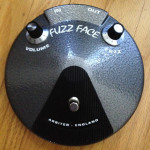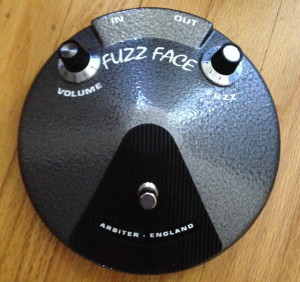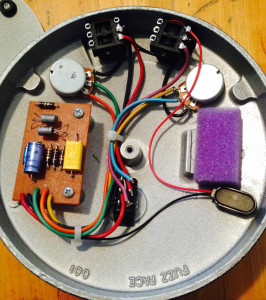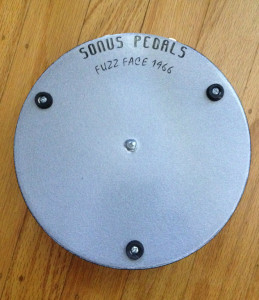It has been some time since we wrote our Fuzz Feast series about both vintage and  recent fuzz options on the market. After seeing the prices of original fuzz units climb, I wondered what the boutique market now had available in 2015 as far as the most accurate of Fuzz Face clones. During my search, I stumbled across Sonus Pedals based in the Netherlands and its Fuzz Face 1966 replica.
recent fuzz options on the market. After seeing the prices of original fuzz units climb, I wondered what the boutique market now had available in 2015 as far as the most accurate of Fuzz Face clones. During my search, I stumbled across Sonus Pedals based in the Netherlands and its Fuzz Face 1966 replica.
There are many incarnations of the Fuzz Face made today, and with the popularity of Jimi Hendrix and his classic lead tones showing no signs of diminishing, a Fuzz Face remains a popular tool to help obtain those searing violin-like lead tones. It’s well known that Hendrix used a germanium-based fuzz for the first three albums, so my focus and interest was piqued when I found the Sonus Fuzz Face 1966 replica.
I discovered the Sonus Fuzz Face 1966 is a fuzz that has been created by a team obsessed with delivering the most accurate of the best original Fuzz Faces. Of course they are also huge fans of Jimi Hendrix. Original Fuzz Faces used germanium NKT275 transistors made by the New Market  company in England that, in best form, delivered a Fuzz Face sound that could provide high-gain distortion that was highly touch-sensitive and cleaned up well by rolling off the guitar’s volume control. Unfortunately, germanium transistors were not consistent in the amount of gain or leakage present. This resulted in Fuzz Face units that varied quite a bit in how they sounded. This also made them a crapshoot when purchasing new back then, and certainly even more so when trying to secure a vintage one today – never mind the thousands of dollars in price you will need to shell out for an original of this era!
company in England that, in best form, delivered a Fuzz Face sound that could provide high-gain distortion that was highly touch-sensitive and cleaned up well by rolling off the guitar’s volume control. Unfortunately, germanium transistors were not consistent in the amount of gain or leakage present. This resulted in Fuzz Face units that varied quite a bit in how they sounded. This also made them a crapshoot when purchasing new back then, and certainly even more so when trying to secure a vintage one today – never mind the thousands of dollars in price you will need to shell out for an original of this era!
The Sonus Fuzz Face 1966 was designed to be a “cherry-picked” recreation of the best of the original Fuzz Faces. It uses genuine New Old Stock (NOS) New Market NKT275 transistors which are selected for optimal gain and low noise characteristics. For those who don’t know, not all NKT275s are what they seem – these are NOT the reissue NKT275 transistors made today which are simply marketed as NKT275s, nor are they the skinny-bodied NKT275s manufactured in Bulgaria in the 1980s.
The details found on the Sonus Fuzz Face 1966 don’t end with the transistors. It is also offered in two beautiful finishes (hammertone grey or black) that are painted to  match the originals, adorned with era-correct styled knobs and circuit board using NOS components including Philips capacitors and 1960’s-era Allen Bradley resistors. The Fuzz Face itself is a simple circuit, which means that the actual components chosen matter even more when listening to the final result. It’s a beautiful replica, but how does it sound?
match the originals, adorned with era-correct styled knobs and circuit board using NOS components including Philips capacitors and 1960’s-era Allen Bradley resistors. The Fuzz Face itself is a simple circuit, which means that the actual components chosen matter even more when listening to the final result. It’s a beautiful replica, but how does it sound?
The key to getting the most out of the Fuzz Face is to use it against an amp that is already clipping. Even Patrizio at Sonus Pedals took some time to weigh in with his thoughts on the Fuzz Face circuit and told me,”It’s how the amp reacts to the strangely distorted and boosted signal that creates the magic,” and admitted that a Fuzz Face on its own really doesn’t sound that good. He warned then that beginners that are buying into fuzz hype should avoid using one until they have the guitar and amp that provides a good basis for their tone.
“A good fuzz is icing on the cake, not the cake itself and that is the reality of this weird little pedal,” he added.
While the Fuzz Face 1966, like other quality fuzz units I’ve used, has a novel fuzz sustaining effect when playing against a purely clean amp, it’s when there’s some overdrive already happening with a tube amp, that the thickening tones and character of the effect really comes through. You can close your eyes and play homage to Jimi and feel you’re there. It’s  a unique experience for guitarists to hear and the end result is fantastic using the Fuzz Face 1966 as a solo boost that is dripping with harmonic overtones. And touch sensitivity? Absolutely does so very well with a quick roll off of my Strat’s volume knob.
a unique experience for guitarists to hear and the end result is fantastic using the Fuzz Face 1966 as a solo boost that is dripping with harmonic overtones. And touch sensitivity? Absolutely does so very well with a quick roll off of my Strat’s volume knob.
While the Fuzz Face itself is most famous as a lead tool used with a Strat and Marshall amp, I had some fun using the Fuzz Face 1966 with my Les Paul as well. It produced some thicker lead tones, but didn’t get overly wooly or uncontrollable on the low end as is often the case with some reissue Fuzz Faces out there. And it was surprisingly quiet as far as extra noise. These are excellent and well-biased transistors indeed in this circuit.
At $399, and built to order with a wait period of 6 weeks, the Sonus Pedals (www.sonus-pedals.com) 1966 Fuzz Face replica isn’t the lowest-price Fuzz Face replica or clone out there, and in fact, Sonus offers other models in its lineup in a standard enclosure (for those who simply want the tone and care little about the cosmetics). But with that said, there is something really nice about enjoying this recreation that is both visually and sonically as close to the originals as it is. I appreciate Patrizio and the Sonus team for taking the time with the details. I’ve not experienced anything else quite as unique nor as accurate as the Sonus 1966 Fuzz Face replica. And to say that among a field of countless Fuzz Face clones makes the Sonus a compelling choice for many fuzz fans.